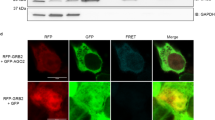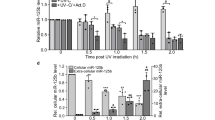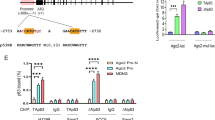Abstract
The tumor suppressor p53 is central to many cellular stress responses. Although numerous protein factors that control p53 have been identified, the role of microRNAs (miRNAs) in regulating p53 remains unexplored. In a screen for miRNAs that modulate p53 activity, we find that miR-29 family members (miR-29a, miR-29b and miR-29c) upregulate p53 levels and induce apoptosis in a p53-dependent manner. We further find that miR-29 family members directly suppress p85α (the regulatory subunit of PI3 kinase) and CDC42 (a Rho family GTPase), both of which negatively regulate p53. Our findings provide new insights into the role of miRNAs in the p53 pathway.
This is a preview of subscription content, access via your institution
Access options
Subscribe to this journal
Receive 12 print issues and online access
$189.00 per year
only $15.75 per issue
Buy this article
- Purchase on Springer Link
- Instant access to full article PDF
Prices may be subject to local taxes which are calculated during checkout





Similar content being viewed by others
References
Vousden, K.H. & Prives, C. P53 and prognosis: new insights and further complexity. Cell 120, 7–10 (2005).
Martins, C.P., Brown-Swigart, L. & Evan, G.I. Modeling the therapeutic efficacy of p53 restoration in tumors. Cell 127, 1323–1334 (2006).
Ventura, A. et al. Restoration of p53 function leads to tumour regression in vivo. Nature 445, 661–665 (2007).
Bossi, G. & Sacchi, A. Restoration of wild-type p53 function in human cancer: relevance for tumor therapy. Head Neck 29, 272–284 (2007).
Kastan, M.B. Wild-type p53: tumors can't stand it. Cell 128, 837–840 (2007).
Murray-Zmijewski, F., Slee, E.A. & Lu, X. A complex barcode underlies the heterogeneous response of p53 to stress. Nat. Rev. Mol. Cell Biol. 9, 702–712 (2008).
Brooks, C.L. & Gu, W. Dynamics in the p53-Mdm2 ubiquitination pathway. Cell Cycle 3, 895–899 (2004).
Galluzzi, L., Morselli, E., Kepp, O., Tajeddine, N. & Kroemer, G. Targeting p53 to mitochondria for cancer therapy. Cell Cycle 7, 1949–1955 (2008).
Das, S., Boswell, S.A., Aaronson, S.A. & Lee, S.W. P53 promoter selection: choosing between life and death. Cell Cycle 7, 154–157 (2008).
Bartel, D.P. MicroRNAs: genomics, biogenesis, mechanism, and function. Cell 116, 281–297 (2004).
Lee, Y.S. & Dutta, A. MicroRNAs in cancer. Annu. Rev. Pathol. published online, doi:10.1146/annurev.pathol.4.110807.092222 (25 September 2008).
O'Donnell, K.A., Wentzel, E.A., Zeller, K.I., Dang, C.V. & Mendell, J.T. c-Myc-regulated microRNAs modulate E2F1 expression. Nature 435, 839–843 (2005).
Johnson, S.M. et al. RAS is regulated by the let-7 microRNA family. Cell 120, 635–647 (2005).
Lee, Y.S. & Dutta, A. The tumor suppressor microRNA let-7 represses the HMGA2 oncogene. Genes Dev. 21, 1025–1030 (2007).
Volinia, S. et al. A microRNA expression signature of human solid tumors defines cancer gene targets. Proc. Natl. Acad. Sci. USA 103, 2257–2261 (2006).
Zhang, L. et al. microRNAs exhibit high frequency genomic alterations in human cancer. Proc. Natl. Acad. Sci. USA 103, 9136–9141 (2006).
Lu, J. et al. MicroRNA expression profiles classify human cancers. Nature 435, 834–838 (2005).
Iorio, M.V. et al. MicroRNA gene expression deregulation in human breast cancer. Cancer Res. 65, 7065–7070 (2005).
Murakami, Y. et al. Comprehensive analysis of microRNA expression patterns in hepatocellular carcinoma and non-tumorous tissues. Oncogene 25, 2537–2545 (2006).
Yanaihara, N. et al. Unique microRNA molecular profiles in lung cancer diagnosis and prognosis. Cancer Cell 9, 189–198 (2006).
Roe, J.S. et al. p53 stabilization and transactivation by a von Hippel-Lindau protein. Mol. Cell 22, 395–405 (2006).
Manning, B.D. & Cantley, L.C. AKT/PKB signaling: navigating downstream. Cell 129, 1261–1274 (2007).
Ellenbroek, S.I. & Collard, J.G. Rho GTPases: functions and association with cancer. Clin. Exp. Metastasis 24, 657–672 (2007).
Aznar, S. & Lacal, J.C. Rho signals to cell growth and apoptosis. Cancer Lett. 165, 1–10 (2001).
Huang, Q. et al. The microRNAs miR-373 and miR-520c promote tumour invasion and metastasis. Nat. Cell Biol. 10, 202–210 (2008).
He, L. et al. A microRNA component of the p53 tumour suppressor network. Nature 447, 1130–1134 (2007).
Bommer, G.T. et al. p53-mediated activation of miRNA34 candidate tumor-suppressor genes. Curr. Biol. 17, 1298–1307 (2007).
Raver-Shapira, N. et al. Transcriptional activation of miR-34a contributes to p53-mediated apoptosis. Mol. Cell 26, 731–743 (2007).
Chang, T.C. et al. Transactivation of miR-34a by p53 broadly influences gene expression and promotes apoptosis. Mol. Cell 26, 745–752 (2007).
Tarasov, V. et al. Differential regulation of microRNAs by p53 revealed by massively parallel sequencing: miR-34a is a p53 target that induces apoptosis and G1-arrest. Cell Cycle 6, 1586–1593 (2007).
Pekarsky, Y. et al. Tcl1 expression in chronic lymphocytic leukemia is regulated by miR-29 and miR-181. Cancer Res. 66, 11590–11593 (2006).
Porkka, K.P. et al. MicroRNA expression profiling in prostate cancer. Cancer Res. 67, 6130–6135 (2007).
Fabbri, M. et al. MicroRNA-29 family reverts aberrant methylation in lung cancer by targeting DNA methyltransferases 3A and 3B. Proc. Natl. Acad. Sci. USA 104, 15805–15810 (2007).
Mott, J.L., Kobayashi, S., Bronk, S.F. & Gores, G.J. mir-29 regulates Mcl-1 protein expression and apoptosis. Oncogene 26, 6133–6140 (2007).
Wang, H. et al. NF-κB-YY1-miR-29 regulatory circuitry in skeletal myogenesis and rhabdomyosarcoma. Cancer Cell 14, 369–381 (2008).
Sengupta, S. et al. MicroRNA 29c is down-regulated in nasopharyngeal carcinomas, up-regulating mRNAs encoding extracellular matrix proteins. Proc. Natl. Acad. Sci. USA 105, 5874–5878 (2008).
Hennessy, B.T., Smith, D.L., Ram, P.T., Lu, Y. & Mills, G.B. Exploiting the PI3K/AKT pathway for cancer drug discovery. Nat. Rev. Drug Discov. 4, 988–1004 (2005).
Mayo, L.D. & Donner, D.B. The PTEN, Mdm2, p53 tumor suppressor-oncoprotein network. Trends Biochem. Sci. 27, 462–467 (2002).
Wu, F. et al. RNA-interference-mediated Cdc42 silencing down-regulates phosphorylation of STAT3 and suppresses growth in human bladder-cancer cells. Biotechnol. Appl. Biochem. 49, 121–128 (2008).
Acknowledgements
We thank J. Chung (Korea Advanced Institute of Science and Technology (KAIST)) for the pG13-luc plasmid, D. Park (School of Biological Sciences, Seoul National University) for the CDC42 expression plasmid, H.-D. Youn (College of Medicine, Seoul National University) for the HCT116 cell lines and S. Hee Baek (School of Biological Sciences, Seoul National University) for helpful discussion. We are grateful to the members of our laboratory, particularly C. Joo, W. Jones, J. Han and Y.-K. Kim for critical reading of the manuscript. This work was supported by the Creative Research Initiatives Program (V.N.K.) and by BK21 Research Fellowships (S.-Y.P. and M.H.) from the Ministry of Education, Science and Technology of the Republic of Korea.
Author information
Authors and Affiliations
Contributions
S.-Y.P., J.H.L. and M.H. performed the experiments and analyzed the data; J.-W.N. performed bioinformatic analyses and helped with editing of the manuscript; S.-Y.P., J.H.L. and V.N.K. designed the study and wrote the paper.
Corresponding author
Supplementary information
Supplementary Text and Figures
Supplementary Figures 1–9 and Supplementary Table 1 (PDF 302 kb)
Rights and permissions
About this article
Cite this article
Park, SY., Lee, J., Ha, M. et al. miR-29 miRNAs activate p53 by targeting p85α and CDC42. Nat Struct Mol Biol 16, 23–29 (2009). https://doi.org/10.1038/nsmb.1533
Received:
Accepted:
Published:
Issue Date:
DOI: https://doi.org/10.1038/nsmb.1533
This article is cited by
-
Pan-cancer analysis of mRNA stability for decoding tumour post-transcriptional programs
Communications Biology (2022)
-
Role of microRNAs in regulation of insulin secretion and insulin signaling involved in type 2 diabetes mellitus
Journal of Biosciences (2022)
-
miR-29a sensitizes the response of glioma cells to temozolomide by modulating the P53/MDM2 feedback loop
Cellular & Molecular Biology Letters (2021)
-
CEA, CA 15-3, and miRNA expression as potential biomarkers in canine mammary tumors
Chromosome Research (2021)
-
Dietary alterations modulate the microRNA 29/30 and IGF-1/AKT signaling axis in breast Cancer liver metastasis
Nutrition & Metabolism (2020)



